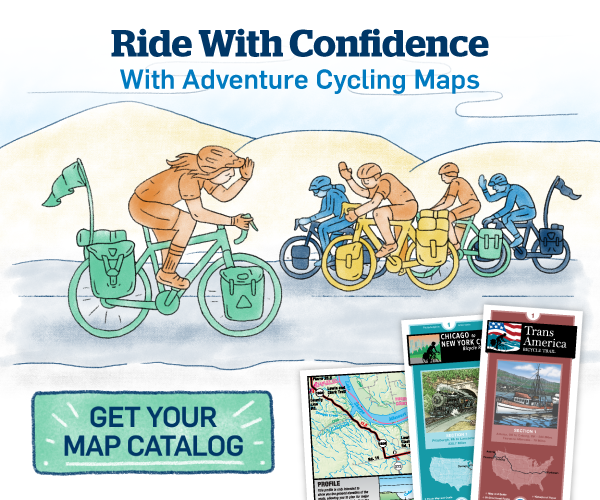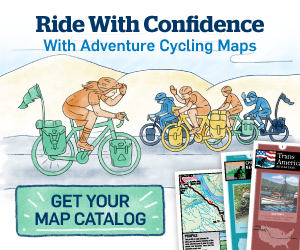Road Test: Trek Checkpoint ALR5 Driftless
This article first appeared in the July/August 2023 issue of Adventure Cyclist magazine.
The Driftless is a special edition of Trek’s Checkpoint gravel bike, and its moniker refers to the Driftless Area of the Midwest — specifically Wisconsin, Trek’s home state. Thanks to the internet, I now know that the Driftless Area was never covered by ice during the last ice age and therefore lacks glacial silt deposits, known as drift. Elsewhere in the Midwest, receding glaciers flattened the landscape; not so in the Driftless, where you’ll find steep hills and deep, narrow river valleys.
Trek’s Checkpoint is available in several iterations in carbon or aluminum and 1x or 2x drivetrains. The Driftless, however, comes in only one spec, but it’s a good one: aluminum frame, carbon fork, 1x drivetrain, dropper post, and bolt-on half framebag. The Driftless is also available in only one color, a dark red that Trek calls — wait for it — Satin Cobra Blood. If that didn’t come out of an ayahuasca fever dream, I don’t know what would. But look closely at the paint and you’ll see topographical lines that, according to Trek, evoke the Driftless Area. It’s a sharp-looking bike. And when you open the framebag, you’ll see the red topo pattern repeated on the interior fabric. That deserves a chef’s kiss right there.
The Driftless comes out of the gate ready for loaded adventures, featuring rack and fender mounts, four bottle mounts, triple mounts on the fork, and mounts for a top tube bag. With the framebag installed on the size 56cm I tested, I was able to fit a small bottle on the seat tube and a large bottle on the downtube. The framebag’s main compartment features three pockets, which is great for keeping things like your phone, wallet, keys, and a multitool handy without bouncing around. If you want to carry more water bottles, you can always remove the framebag to take advantage of the upper downtube bottle position: the inner triangle can carry up to three bottles.
For the drivetrain and brakes, Trek chose high-end Shimano GRX bits, which provided crisp shifting and easy, one-finger braking. With no front derailer, the left shifter is available to actuate the dropper post, a feature I absolutely loved. But with a 40T chainring and an 11–42T cassette, the Driftless had less gearing than I would prefer, especially on a bike named for a region with steep hills and with designs on loaded riding. The Easton dropper post provided only 50mm of travel, which for a bike like this is plenty. It’s just enough to lower your center of gravity but not so much that you can’t still get a few pedal strokes in.
As for the rest of the spec list, it’s a lot of Bontrager-branded stuff that worked quite well. I liked the shape and feel of the handlebar with its 13° flare, but I found the 420mm width a tad narrow. Likewise, the Bontrager wheels rolled just fine, but with only 24 spokes per wheel, they might not be ideal if you plan on really loading this bike up. The GR2 tires rolled quickly on pavement and provided a ton of grip on dirt, and they managed to survive the sharp rocks and scattered broken glass here in Salt Lake City, which is no small feat.
So aside from a cool paint job, a nifty framebag, and a dropper post, it’s just a gravel bike, right? Wrong. Somehow, the Wisconsin brand has created one of the most fun bikes I’ve ever thrown a leg over. The Driftless was screamingly quick on the road, even with its off-road tires — I quickly realized that being able to drop my butt 50mm on canyon descents makes me go much, much faster and with way more confidence — and with its short wheelbase and steep-ish head angle, it was an absolute riot on dirt, especially singletrack. A term we don’t often use in this publication is tossable, as in maneuverable, twitchy. With the slightest input, I could snake this bike around rocks and drift around corners like a hooligan. On one of the most fun days I’ve ever had on a bike, I rode the Driftless 20 miles on pavement to a trailhead, rode 20 miles of singletrack on green and blue mountain bike trails, and then rode 20 miles of pavement home. I couldn’t feel my legs the next day, but it was worth it.
So what’s this bike’s special sauce? I have no idea. The bike felt short and twitchy and pointy, as we say in the mountain bike world, but it was also surprisingly compliant. Something I’ve come to learn recently is that manufacturers have figured out how to make aluminum frames that don’t beat you up, and the Driftless is one such bike. But I also think the carbon fork and the low spoke count of the wheels played a role in the ride feel as well. Without isolating the various factors, it’s hard to point a finger at the source. But I tend to think that Trek hit upon a magical combination, and I’d be wary of replacing any one thing for fear of compromising this bike’s unique qualities.
Trek Checkpoint ALR5 Driftless
Best uses: Road, gravel, light touring, singletrack
Price: $2,800
Frame: Alpha Aluminum, rack and fender mounts, four bottle mounts, top tube mounts
Fork: Carbon, rack and fender mounts, triple mounts
Weight: 22.2 lbs. (with framebag and two bottle cages)
Available sizes: 49cm, 52cm, 54cm, 56cm, 58cm, 61cm
Size tested: 56cm


Comments
When will Trek, or for that matter anyone!, make a decent, lightweight e-bike for carrying bags long distance? Must be metal for touring...
Forgot Password?
Enter your email address and we'll send you an email that will allow you to reset it. If you no longer have access to the email address call our memberships department at (800) 755-2453 or email us at memberships@adventurecycling.org.
Not Registered? Create Account Now.